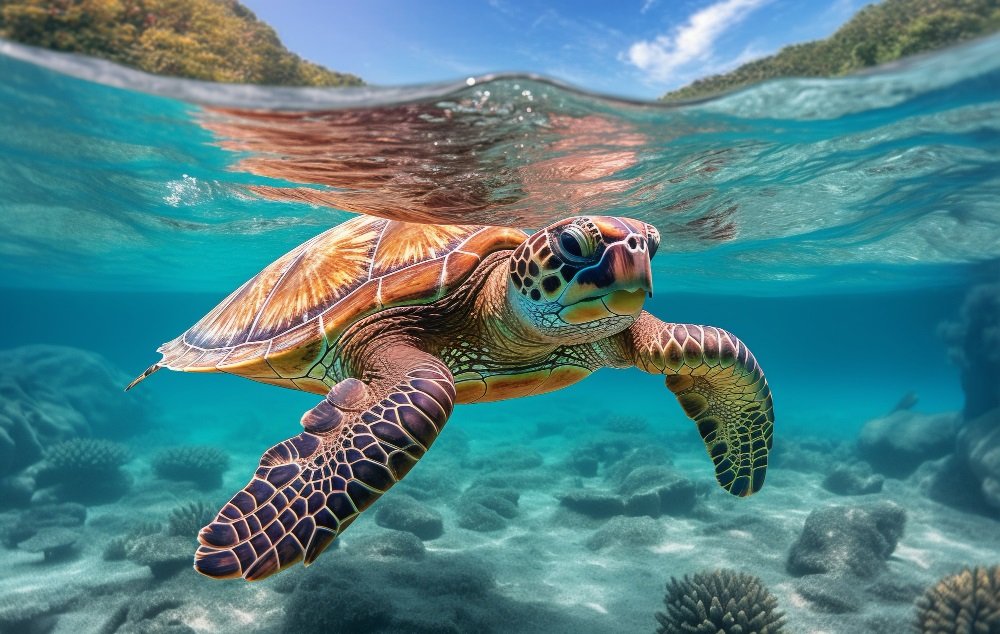Understanding the world’s oceans requires appreciating the incredible creatures that call them home. Among these fascinating inhabitants are the leatherback sea turtles, the largest of all sea turtles and a truly remarkable species.
What Are Leatherback Sea Turtles?
Leatherback sea turtles are ancient mariners, having roamed the Earth’s oceans for millions of years. Their unique characteristics and global distribution make them a vital part of marine ecosystems.
Distinctive Features
Unlike other sea turtles with hard, bony shells, leatherbacks possess a flexible, leathery carapace. This unique adaptation allows them to dive to incredible depths and consume large quantities of jellyfish, their primary food source.
Global Distribution and Migration
Leatherback sea turtles are found in all oceans, from tropical to polar regions. They undertake epic migrations, traveling thousands of miles between feeding and nesting grounds.
What Are Leatherback Sea Turtles?
Leatherback sea turtles (Dermochelys coriacea) are the largest of all living turtles, and indeed, the largest living reptiles. These magnificent creatures are found in all the world’s oceans, migrating vast distances between their feeding and nesting grounds. Their unique appearance, remarkable adaptations, and vulnerable status make them a fascinating subject of study and a species deserving of our protection.
Physical Characteristics
Leatherback sea turtles are easily distinguished from other sea turtle species by their leathery, rubbery carapace (shell) which lacks the hard, bony plates found in other turtles. This unique shell is composed of seven bony plates covered by a tough, flexible skin. Their streamlined bodies are perfectly adapted for life in the water, with powerful flippers that propel them through the ocean with incredible speed and agility.
Size and Weight
Leatherbacks can grow to impressive sizes, with females typically reaching lengths of 6 to 7 feet and weighing up to 2,000 pounds. Males are slightly smaller, averaging 5 to 6 feet in length and weighing up to 1,500 pounds. (See Also: Can Two Female Turtles Live Together)
Coloration
Leatherback sea turtles are typically dark brown or black in color, with lighter markings on their flippers and sometimes on their heads. Their coloration helps them camouflage in the depths of the ocean, blending in with the surrounding environment.
Habitat and Distribution
Leatherback sea turtles are truly global in their distribution, inhabiting all the world’s oceans. They are found in both tropical and temperate waters, ranging from the surface to depths of over 3,000 feet.
Migration Patterns
Leatherbacks are renowned for their incredible migratory journeys, traveling thousands of miles between their feeding and nesting grounds. They typically migrate from their feeding grounds in cold, nutrient-rich waters to warmer, tropical waters to nest.
Diet and Feeding Habits
Leatherback sea turtles are specialized predators, feeding primarily on jellyfish. Their diet can also include other soft-bodied invertebrates such as salps, squid, and comb jellies. Their powerful jaws and sharp beaks are perfectly adapted for capturing and consuming these gelatinous prey.
Unique Adaptations for Jellyfish Consumption
Leatherbacks possess several unique adaptations that allow them to efficiently consume jellyfish:
- Powerful Jaws and Beaks: Their strong jaws and sharp beaks can easily pierce through the tough, gelatinous bodies of jellyfish.
- Flexible Esophagus: Their esophagus is highly flexible, allowing them to swallow large quantities of jellyfish without difficulty.
- Specialized Tongue: Their tongue is covered in small, backward-facing spines that help to trap and hold jellyfish in their mouths.
Reproduction and Life Cycle
Leatherback sea turtles are sexually dimorphic, meaning that males and females have distinct physical characteristics. Females are larger than males and have a more pronounced, heart-shaped carapace.
Nesting Behavior
Female leatherbacks return to the same beaches where they were born to lay their eggs. They typically nest at night, digging a deep nest in the sand and depositing up to 100 eggs. After laying their eggs, females return to the ocean, leaving their offspring to hatch on their own. (See Also: When Do Box Turtles Lay Eggs)
Hatchlings and Development
Leatherback hatchlings emerge from their nests after about 60 days and make a perilous journey to the ocean. They must avoid predators and navigate the treacherous shoreline before reaching the safety of the water. Hatchlings are vulnerable during their first few years of life, facing numerous threats from predators and habitat loss.
Conservation Status and Threats
Leatherback sea turtles are listed as Vulnerable by the International Union for Conservation of Nature (IUCN). They face numerous threats, including:
- Habitat Loss and Degradation: Coastal development, pollution, and climate change are all contributing to the loss and degradation of leatherback nesting and feeding habitats.
- Fishing Bycatch: Leatherbacks are often caught accidentally in fishing gear, particularly in longline fisheries.
- Climate Change: Rising sea levels and ocean acidification are threatening leatherback nesting beaches and their prey populations.
- Pollution: Plastic pollution and other forms of marine debris can entangle leatherbacks or be ingested, leading to injury or death.
Conservation Efforts
Numerous organizations are working to conserve leatherback sea turtles. These efforts include:
- Protected Areas: Establishing marine protected areas to safeguard critical nesting and feeding habitats.
- Fishing Gear Modifications: Promoting the use of fishing gear that is less likely to entangle leatherbacks.
- Public Education and Awareness: Raising awareness about the threats facing leatherbacks and encouraging responsible behavior.
- Research and Monitoring: Conducting research to better understand leatherback biology, behavior, and threats, and monitoring populations to track their status.
Conclusion
Leatherback sea turtles are magnificent creatures that play a vital role in marine ecosystems. They face numerous threats, but through conservation efforts, we can help ensure their survival for generations to come. By understanding their biology, behavior, and the threats they face, we can work together to protect these incredible animals.
Frequently Asked Questions about Leatherback Sea Turtles
What makes leatherback sea turtles unique?
Leatherback sea turtles are the largest of all sea turtles, and the only ones without a hard, bony shell. Instead, they have a leathery carapace, which is made of tough, rubbery skin. This unique adaptation allows them to dive deeper than any other turtle, reaching depths of over 3,000 feet!
What do leatherback sea turtles eat?
Leatherbacks are carnivores with a diet primarily consisting of jellyfish. Their throats are specially adapted to swallow large numbers of these gelatinous creatures. (See Also: Where Do Green Sea Turtles Lay Their Eggs)
Where do leatherback sea turtles live?
Leatherbacks are found in all oceans around the world, but they migrate long distances between their feeding and nesting grounds. They often travel thousands of miles between the tropics and cooler waters.
Are leatherback sea turtles endangered?
Yes, leatherback sea turtles are listed as vulnerable by the International Union for Conservation of Nature (IUCN). They face threats from habitat loss, fishing gear entanglement, pollution, and climate change.
How can I help protect leatherback sea turtles?
You can help by reducing your plastic consumption, supporting sustainable fishing practices, and advocating for policies that protect marine ecosystems. You can also donate to organizations working to conserve these magnificent creatures.



